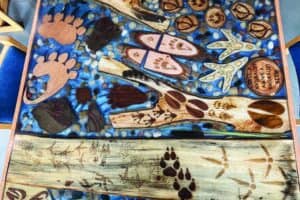Recently, as coronavirus cabin fever erupted, this author noticed an increase in the numbers of visitors to the Calhan Paint Mines. Nearly all of these visitors park their cars and head toward the colorful canyon at the southern end of the park.I would like to suggest a different objective at the east-central loop of the Green Trail. That feature is what geologists call a paleo-mudslide with an associated ìlag depositî of exotic boulders that tell a story of a past climate very different from today. Note: The Green Trail is the trail that connects the lower parking area No. 1 to the upper parking area No. 3.Coloradoís recent geologic history: Having existed for 40 million years, the Western Interior Seaway drained away into the ocean 62 million years ago. At its maximum extent, this seaway extended from the Arctic Ocean to the Gulf of Mexico. Toward the end of this time, the dinosaurs ceased to exist after a large meteor had annihilated them.With the withdrawal of the sea, most of Colorado was reduced to a flat alluvial plain. Then another geologic disaster: 37 million years ago, a cataclysmic volcanic eruption occurred near Salida. A cloud of molten ash rushed 70 miles across the alluvial plain; in low areas a deposit of rhyolite and pyroclastic tuff (Castle Rock Rhyolite) that was 20 feet thick accumulated at Castle Rock and Castlewood Canyon.Erosion of the Rhyolite formed detrital material that was incorporated into the Castle Rock Conglomerate 34 million years ago. This is the hard cap-rock you see on the hills from Castle Rock to Calhan. Along with the Rhyolite, another exotic rock, the Coal Creek Quartzite was also incorporated into the Conglomerate. This exceptionally hard rock is special to geologists; it is 1.7 billion years old. Its origin is a small exposure in Coal Creek Canyon, west of Golden.The stream mouth altitude of Coal Creek at Golden is 6,609 feet. The Palmer Divide is higher than that all the way to the Paint Mines. How then, did the Conglomerate get onto the Palmer Divide (8,000ñ7,000 feet high) and across the eastern plains? Thirty-four to 23 million years ago, streams, including the ancestral Cherry Creek, flowed southeast toward the Arkansas River. This drainage pattern was later reversed as the Denver Basin subsided northward and the Raton Basin sagged toward the south. The Palmer Divide was left high.The ìlag deposit:î Today, throughout the Paint Mines, one finds rocks appearing along the creek beds and on the uplands east of the park. Rounded boulders of Rhyolite and blue-gray Quartzite are found everywhere. This is a lag deposit ó residual material left behind from eroded conglomerate that once covered the area. The ìlagî is especially abundant at the east-central loop of the Green Trail.The mudslideBelow the loop of the Green Trail there is a long curvilinear bluff with well-defined nearly horizontal strata. These rocks are identified as the Dawson Arkose unit D2. As this bluff curves toward the southwest, it suddenly changes its organization and ends in a distorted ìmassî or ìheap.îMinor sorting of clasts is present, but little stratification is evident in this mass. Probably, these rocks originated high up on the bluffs of a river and slumped down into the river channel. The rocks in the mass are Conglomerate, once several-hundred feet above the Dawson D2, now lying adjacent to the D2. On closer inspection, one notices the jagged topography across the top of the mass. The larger exposed boulders are sandstone, with ragged crusts of hematite. These hematite crusts are usually found as discrete horizontal layers stratified with the D2 sandstone beds. Now, they are rolled up into the sandstone boulders.Incorporated into the ìmassî are boulders and cobbles of Rhyolite, with a few Quartzite cobbles. This is Castle Rock Conglomerate.Rocks found within the mudslide are also scattered over the landscape. Lying west of the mass, an abundance of loose detrital cobbles and boulders may be found attesting to the former presence of a more extensive Conglomerate stratum. These remnants tell both the age of an event (a mudslide canít be older than the rocks found in it); and, importantly, the derivation of the rocks found in the channel indicate two distinct sources.We know that the Rhyolite came from a volcano near Salida and was deposited in a band from there to Castle Rock. Second, that blue Quartzite (1.7 billion years old) is only found intact in Coal Creek Canyon near Golden. These two rocks were brought together near Castle Rock by a river system that flowed from northwest to southeast. The large size of the detrital material indicates a strong flow of water during flooding periods. This is a different climate and drainage system than today. The alluvial plain was an environment of swamps and lakes.Ancestral Cherry Creek would have been a river often times swollen to flood-stage and capable of transporting the large boulders southward.The climate in central Colorado 34 to 23 million years ago was warm and covered by temperate forests. A fossil rainforest of this age was found next to I-25, near Castle Rock. In Castle Pines, a forest of redwood and other trees thrived; its beautiful butterscotch color petrified wood is found in the Paint Mines. The paleo-Indians used this material for arrowheads and other tools.What do the colored rocks in the canyon tell us?The colors displayed are pigments in clays that are weathering products of igneous rocks sourced from the eroding ancient Rocky Mountains. Yellow indicates reduction of iron minerals, red the oxidation of iron. ìLaterite pansî (yellow or dark brown splotches on the ground) speak of tropical or subtropical areas where spring water laden with iron rose to the surface, and iron participated as bog iron (hematite).Black is either the low rank coal-lignite or the iron mineral hematite both formed in swampy conditions. Bentonite clay sourced from volcanic tuff can give yellow, green, tan and purple colors and will form un-vegetated badlands and hoodoos (weathered rock) as at the Paint Mines.Geology involves interpretation. The colors of the rocks, the surface lag deposits and the unappreciated mudslide mass tell us a story of previous volcanism, erosion and surface instability during storm events.See Paul Denney featured in People on the Plains.






